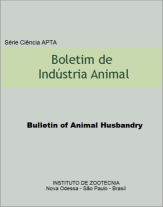Diet and bioclimatic conditions on production and milk quality
DOI:
https://doi.org/10.17523/bia.v74n4p328Palavras-chave:
environment, roughages, intake, nutrition, ruminantResumo
It was aimed to analyze the productive performance of lactating cows on isoprotein fed diets, at differentiated environmental conditions. Eight Holstein cows were used, grouped in two 4 × 4 balanced Latin squares design. The treatments were evaluated in 2 × 2 factorial designs: sources of roughage (corn silage €“ CS plus concentrate, and the combination of corn silage with sugarcane - CSSC, 1:1 on DM, plus concentrate) and distinct environment (with= WS and without= OS, fan and nebulizers system= Sfn). The estimation of dry matter intake (DMI), productive performance and physicochemical parameters of milk were evaluated. There was no interaction effect of environment factors and source of forage. There was signiÀ cant effects for the source forage factors, where the DMI for the CSSC based diet was higher than the CS based diet in the effect of forage (4.22 vs. 4.06% BW, and 22.3 vs. 21.7 kg/d, respectively, P‰¤0.05), but with similar milk production correcting 3.5% fat (23.01 vs. 22.62, CSSC and CS; 22.85 vs. 22.78 kg/day, WS and OS, respectively, P‰¥0.05). The feed efÀ ciency and conversion was similar in both factors (102.8 vs. 104.7% and 0.99 vs. 1.0, CSSC and CS; 102.5 vs. 104.9% and 1.0 vs. 0.99, WS and OS, respectively, P‰¥0.05). The beneÀ t-diet cost ratio was higher for CS-based diet than for CSSC (7.44 vs. 6.97, P‰¤0.05). There were effects only in the forage factor for CP milk (3.26 vs. 3.23%, P‰¤0.05), lactose (4.54 vs. 4.49%, P‰¤0.05) and urea nitrogen in milk (23.21 vs. 20.71 mg/dL, P‰¤0.05) and the superiority arising from the CSSC-based diet in comparison to the CS diet. There was higher for T and THI (28.1 vs. 23.6°C and 75.1 vs. 71.1, respectively, P‰¤0.05), and lower RH to 2:00 pm (47.7 vs. 64.5%, P‰¤0.05). The linear score showed negative correlations with DMI, milk production, lactose and urea nitrogen (-0.36, -0.69, -0.44 and -0.32, P‰¤0.05, respectively). The use of the diet based on CSSC proposed increases in DMI and milk quality without affecting production, but with smaller beneÀ t-diet cost ratio. The use of the environmental cooling system did not improve the production, qualitative parameters of milk and thermal comfort of dairy cows under the conditions evaluated.Downloads
Downloads
Publicado
Edição
Seção
Licença
Os autores não serão remunerados pela publicação de trabalhos, pois devem abrir mão de seus direitos autorais em favor deste periódico. Por outro lado, os autores ficam autorizados a publicar seus artigos, simultaneamente, em repositórios da instituição de sua origem, desde que citada a fonte da publicação original seja Boletim de Indústria Animal. A revista se reserva o direito de efetuar, nos originais, alterações de ordem normativa, ortográfica e gramatical, com vistas a manter o padrão culto da língua e a credibilidade do veículo. Respeitará, no entanto, o estilo de escrever dos autores. Alterações, correções ou sugestões de ordem conceitual serão encaminhadas aos autores, quando necessário. Nesses casos, os artigos, depois de adequados, deverão ser submetidos a nova apreciação. As opiniões emitidas pelos autores dos artigos são de sua exclusiva responsabilidade. Todo o conteúdo deste periódico, exceto onde está identificado, está licenciado sob a Licença Creative Commons Attribution (CC-BY-NC). A condição BY implica que os licenciados podem copiar, distribuir, exibir e executar a obra e fazer trabalhos derivados com base em que só se dão o autor ou licenciante os créditos na forma especificada por estes. A cláusula NC significa que os licenciados podem copiar, distribuir, exibir e executar a obra e fazer trabalhos derivados com base apenas para fins não comerciais.













